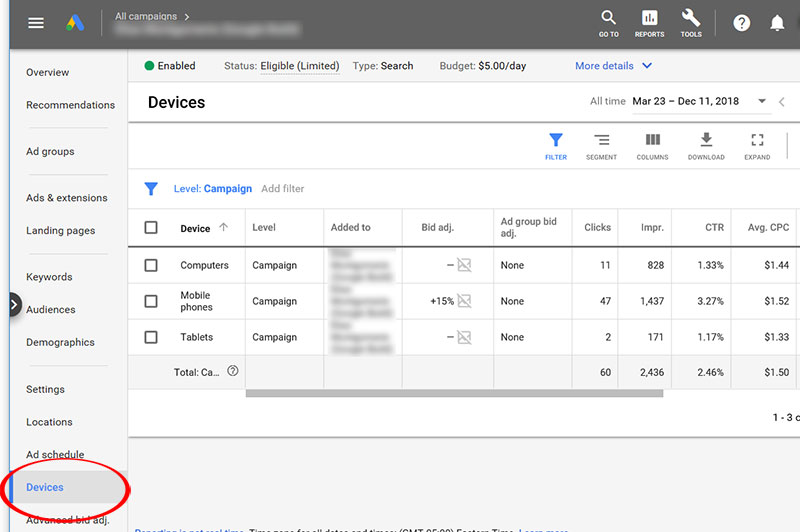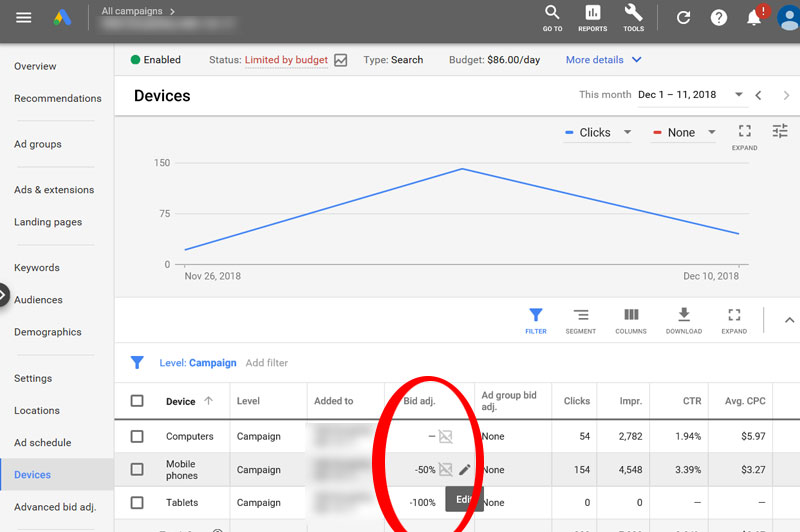Google ad performance can be broken out and adjusted based on three major categories of device type:
• Computers
• Mobile phones
• Tablets
Google provides performance data for each type of device and allows you to adjust your campaigns to serve more or fewer ads for each device type. The reason this is important is that you may get very different types of results based on the type of device where your ads are viewed.
If you think logically about the following things, you may have a good notion of what device type will be most effective for your ad campaigns:
• Who your customer base is
• The type of product or service you provide
• The purpose of the ads
Let’s start with your customer base. Who are you selling to? If you are selling to teenagers or hipsters, then your market may be much more likely to purchase products from their phones. If you are selling mostly to business people, then your market may tend to make purchases or do research on a computer. I have found that tablets tend to generate the least traffic of the three device types.
Similarly, the type of product or service you are selling may make a significant different to the type of device that works best for your ads. Selling music downloads? Then mobile is likely to be most effective. Selling business-to-business services? Computer or tablet may be most effective.
The purpose of the ads is a big one. If you are selling products, then again, it might depend heavily on who you are selling to. However, if you are using ads to generate leads, then your ads may perform much better on a computer. That is because filling out forms is still a real pain in the ass on mobile devices. The longer and more complicated the form, the more difficult it is to complete on small screens. In that situation, you may end up wasting your money running ads on mobile devices because they are unlikely to convert.
And now a warning: sometimes you just don’t know, and even if you think you know…you really probably don’t know. Unless it is extremely obvious what type of device you should target, you should probably start by just running ads across all devices and letting your data tell you what works best.
So how exactly do you know this? By viewing the Devices screen for your campaigns, as shown in the following image:

You can view this data for all campaigns at once or for each campaign individually. If you use conversion tracking, then this data is even more valuable because you will know exactly how to increase conversions. If you don’t have conversion data, you will have to rely on clicks, click-through rate and cost per click as your decision-making metrics.
Once you have enough data to make a decision, you can adjust your bids by device. Click the pencil icon in the Bid adjustment column to change how you bid for each device. If you want to completely stop showing your ads for a device type, adjust the bid adjustment slider all the way down to zero. In the image below, this campaign has been adjusted so that bids for mobile devices are 50% less, and bids for tablets are 100% less, meaning ads will not show on tablets at all.

Adjusting bids by device type is a powerful way to improve the performance of your Google ads by showing your ads more on the type of device that is most likely to generate traffic or conversions, or where you have the most favorable cost per conversion. You should use this strategy for your own Google Ads campaigns.
If you could use some help managing your Google ads (or just getting started), get in contact with Work Media today. We’re here to help!

